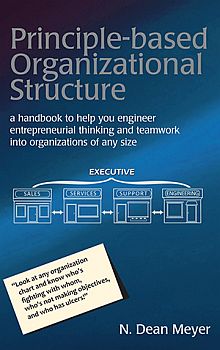| Excerpt from www.NDMA.COM, © 2025 N. Dean Meyer and Associates Inc.
Executive Summary: The Seven Principles of Structure
these seven Principles guide the design of organization charts, forming the foundation of the engineering science of organizational structure
by N. Dean Meyer
These seven Principles guide the design of organization charts:
Principle 1: Golden Rule
This first Principle is the most fundamental, absolutely essential to the success of every organization: Authority and accountability must always match. If ever authorities and accountabilities are separated, serious problems inevitably arise:
An IT example: Operations runs whatever Engineering builds....
Let's say you're in charge of IT operations. Your job is delivering infrastructure-based services reliably and efficiently. But what if you have little say over what goes into your data center. IT engineers decide that for you. How would you feel? Disempowered, to be sure. You probably realize that you're set up to fail. Look at the incentives built into the organization. Engineers love innovation and are rewarded for their technology designs, but they aren't held accountable for cost-effective, stable operations. In pursuit of the "right" technologies, you'll be given the latest and greatest... at any cost. And when the engineers decide to try out some bleeding-edge product, you'll take the fall when it proves unreliable. This structure is like allowing Boeing to decide what airplanes Delta Airlines will use. How can we hold operations accountable for the performance of their services when they have no say over what their infrastructure looks like!? The answer is, we can't. Authority must match accountability, in every part of the organization, all the time. This is the "golden rule" of organizational design. When IT engineers have the authority to design the infrastructure, the operations group becomes a passive dumping ground. It cannot be held accountable for the cost or quality of its services. This is absolutely counter to the vision of a healthy organization where everybody is an internal entrepreneur who's empowered to run a business within the business. In a healthy organization, everybody is accountable for their own results, and is empowered with authority over all the information, resources, and decision powers they need to do their jobs. The Golden Rule affects the design of an organization's structure, culture, resource-management processes, and metrics. Specifically with regard to structure, the Golden Rule tells us this:
Principle 2: Specialization and Teamwork
We have only so many "brain cycles" each day. We can only think so many thoughts; we can only read so much; we can only remember so much. Therefore, we can only be world-class experts at one thing at a time. We may rotate among specialties in the course of our careers. But at any point in time, we must concentrate on a single profession to master it. Some of the benefits of specialization include:
The whole point of forming organizations is to permit people to specialize. When specialists in a diverse range of fields are brought together, an organization has both depth and breadth. Within some practical limits, the more that people specialize, the better they (and the organization) perform. Conversely, an organization of generalists performs no better than an equal number of individuals. Specialization is key to performance. But there is a catch.... The more people specialize, the more they become interdependent. For most things, specialists can't "go it alone." Put simply, you can't specialize if you can't team. Teamwork is often the gating factor. If an organization isn't good at cross-boundary teamwork -- assembling just the right mix of specialists onto teams, and getting them to work well together -- then groups must be independent rather than interdependent. In such a "siloed" organization, each profession is scattered among the various groups that need it. This reduces specialization, since each member of that profession within each silo must cover the entire profession, not focus on a sub-specialty. Without teamwork, the benefits of specialization are lost. The best organizations maximize specialization and invest in effective cross-boundary teamwork.
Principle 3: Precise Domains
An organization chart determines everybody's "domains" -- the boundaries within which each group functions. Sometimes a group's domain is defined only by the few words in a box. When different people interpret those few words in different ways, three problems occur: overlaps, gaps, and a lack of focus. Precise domains require a more detailed explanation of the boundaries than a few words in a box. Beyond level of detail, there's also the question of how boundaries are defined. Traditional "roles and responsibilities" aren't the answer. They blur accountabilities and authorities because they define people's tasks rather than outcomes (products and services). Defining roles and responsibilities (tasks) begs the question, who's accountable for results -- the organization's products and services? Even the more sophisticated "RACI" framework focuses on tasks rather than results, and risks separating authorities from accountabilities. The key to good boundaries is defining what people produce rather than what they do. This is fundamental to empowerment -- managing people by results, not dictating how they do their jobs. Dividing up results is actually a lot easier than sorting tasks. The list of an organization's products and services is far shorter than all the tasks people do and roles they play. And by defining who produces what, you'll automatically know who does what. In summary, a healthy structure provides every group with precisely worded boundaries. It ensures no overlaps (internal competition) and no gaps. And domains bound what people produce, not the roles they play or the tasks they do.
Principle 4: Basis for Substructure
If an organization is big enough to require multiple groups in essentially the same profession, how do you divide responsibilities among those multiple groups? The way you divide a specialty into sub-domains is termed the "basis for substructure." Structure determines each group's focus. And you want people to focus on excellence in their specialties. Therefore, use a basis for substructure that exactly matches what people are supposed to be good at. There's no one right answer for an entire organization. A substructure that's right for one function may be wrong for another. But once you know what a function is supposed to be good at (its specialty), the right basis for substructure should be evident. For example, if the job is knowing clients (Sales), then the right basis for substructure is territories of clients. On the other hand, if the job is developing solutions (Engineering), then the right basis for substructure is the various engineering disciplines (technologies).
Principle 5: Avoid Conflicts of Interests
There are five fundamental conflicts of interests inherent in all businesses, and in businesses within a business:
When structure tells an individual to go in two (or more) opposing directions, it creates conflicts of interests. There are adverse consequences both for the organization and for the people involved: Gaps: Putting people in conflict-of-interests situations doesn't produce excellence at both missions. With finite time and attention, people might be mediocre at both missions. More commonly, they prefer one (based on their predilections), and performance at the other mission falls short (a gap). Unpredictable balance: The balance between conflicting missions is not a deliberate process -- an interplay among peers that analyzes trade-offs. Individuals decide the balance based on their limited view of the organization's needs, their intuitions, and personal preferences. As one manager leans one way and another in the other direction, when their decisions are added up, there will be a tendency toward the mean -- regardless of the needs of the business at that time. Meanwhile, the organization's top executive has little control over the balance -- there's no knob to turn, no explicit way to adjust the balance on these conflicting objectives when it's left to each manager's intuition and preference. Stress: A more personal consequence is stress. When people are expected to go in opposing directions, they're torn; and typically they're fully aware of their failure to succeed at both. Highly stressful jobs lead to poor motivation, performance deficiencies, and even health problems. Since every organization faces all these conflicts of interests, its top executive inevitably must cope with all these paradoxes and decide the balance point on each. But at lower levels, it's not healthy to combine functions with opposing objectives. This leads to a simple structural guideline: Reserve conflicts of interests for the highest possible level in the organization chart, ideally for the organization's top executive alone. A healthy structure defines jobs that focus on only one side of each paradoxical dimension. This gives staff clear, non-conflicting job objectives. And it allows the executive to explicitly adjust the balance by shifting resources between groups.
Principle 6: Cluster by Professional Synergies
When you combine domains under a manager, what goes best with what? As long as you're willing to invest in teamwork, you don't need to put diverse professions under a common boss just to get them to work together. This gives you the freedom to cluster domains by profession, and gain many kinds of synergies:
The simple guideline for structure is: Cluster domains based on professional synergies (not who works with whom). Put all groups in the same profession together under a common boss.
Principle 7: Business Within a Business
An organization chart determines everybody's specialty. Principle 7 describes the best way to define that specialty. It's simply this: Each group should be treated as a business within a business. This inherently satisfies the first six principles:
The business-within-a-business paradigm brings out the best in people. It sends all the right signals and rewards the right behaviors, harnessing everybody's creativity in service of an enterprise's best interests.
Organizational structure is the key to achieving such an entrepreneurial organization.
The guideline for structure is: Define groups as lines of business, bounded by the products and services they produce -- by what each "sells," not what it does.
The Building Blocks are a taxonomy of all the lines of business that exist within organizations. These Building Blocks are the ideal way to define groups in an organization chart.
|



